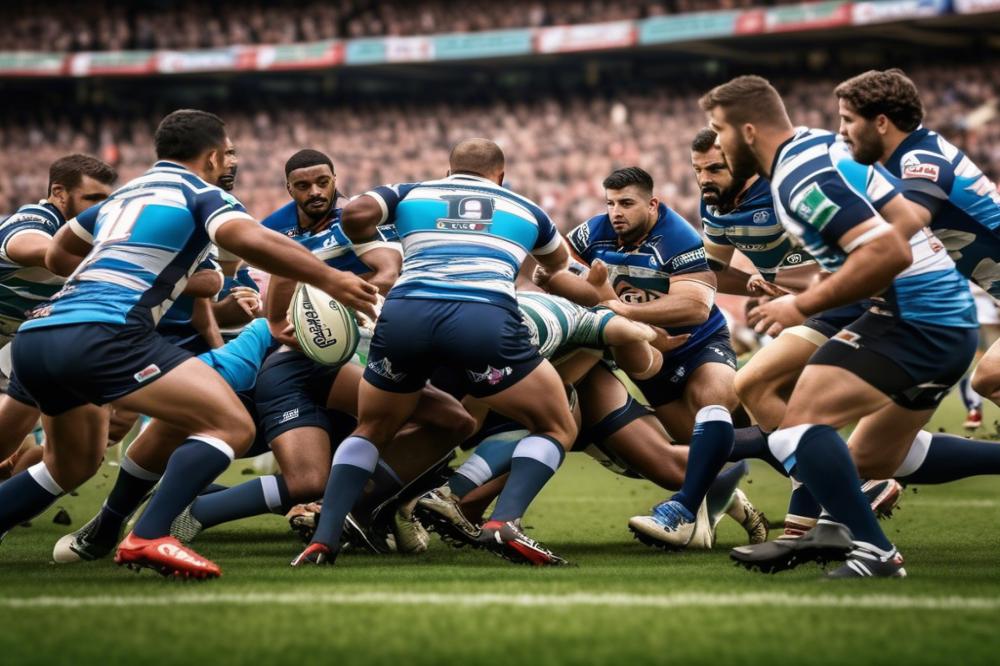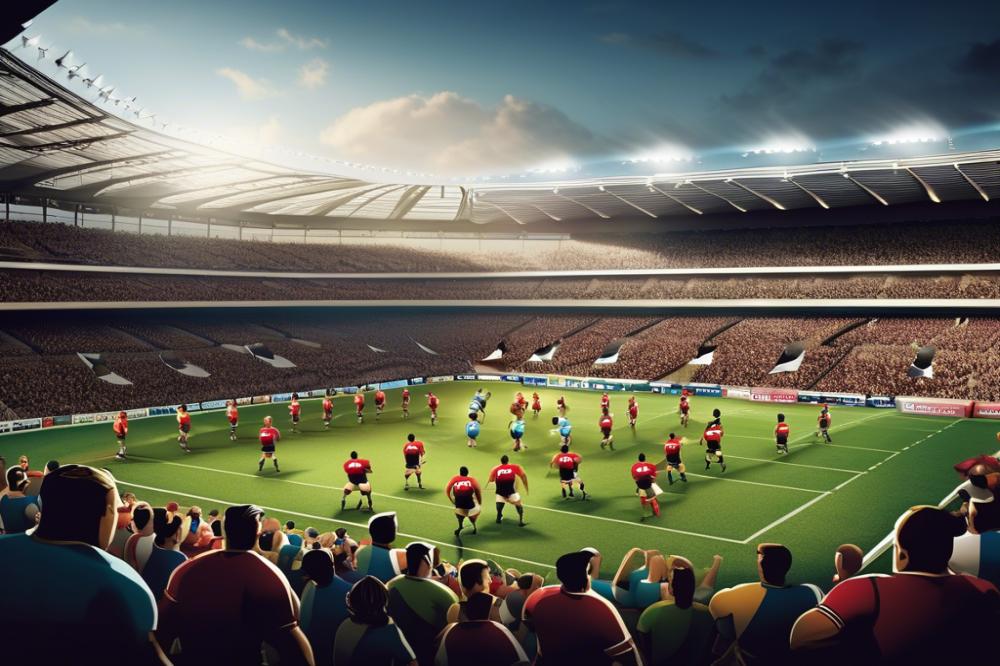How halfbacks Control the Tempo of a rugby league Game
In the exhilarating world of rugby league, a crucial position often goes underappreciated by casual observers but holds immense responsibility on the field. halfbacks possess a natural role as key playmakers within their teams. At its core, controlling the game tempo anchors their function. This pivotal element shapes how the match unfolds and determines its rhythm.
Halfbacks are not just participants; they are the master strategists in the thick of the action. Their role goes beyond mere execution. It encapsulates understanding field strategy and seamlessly integrating it with the team’s overall design. A well-timed tactical decision can change the whole complexion of a match.
Game management is a skill these players refine through experience and instinct. They must evaluate situations quickly and choose the best plays, whether that involves a solid kicking game or directing set plays to advance their team. Their ability to dissect defense lines and identify gaps sets them apart.
A skilled halfback offers more than strategic insights; they embody on-field leadership with assertive yet adaptable guidance. Communicating attacking structures and coordinating defensive organization require more than mere talent. Leadership thrives in urgency.
In essence, the halfback is the linchpin in rugby league, masterfully weaving all these elements together. Their influence extends beyond the immediate play, shaping the broader narrative of the match. Players in this position carry unique burdens, balancing quick decisions and nuanced comprehension of the evolving game dynamics.
The Role of Halfbacks in game tempo

Halfbacks are pivotal in orchestrating the rhythm of a rugby league game. As the playmaker, they control the tempo by dictating the speed and flow of play. Their decisions impact every moment on the field. When halfbacks decide to quicken the pace, they catch the defense off guard. Rapid passes and strategic kicks open opportunities for their team. By slowing things down, they give their side a chance to regroup and plan the next move.
In the attacking phase, halfbacks contribute significantly to set plays and attacking structures. They analyze the opposing team’s defense and find gaps to exploit. Choosing to kick strategically can turn defense into attack, catching opponents unprepared. A good kicking game enhances their ability to influence field position, creating advantageous scenarios for the attacking team. This requires strategic foresight and impeccable timing, skills at which top halfbacks excel.
During defensive transitions, they shine with their game management skills. Commanding the team’s defensive organization, they lead with composure. Communication on the field ensures everyone is aligned and aware. Halfbacks read the opponent’s intent swiftly, adjusting tactics on the fly. Their on-field leadership keeps their teammates motivated and focused. Decisions, often made in mere seconds, can stop the opposition in its tracks, maintaining control over the game tempo.
Through tactical decisions, they steer the direction of the match. With every pass, kick, and call, they are constantly shaping the game’s flow. Intentional variations in pace surprise opponents and maintain unpredictability. Their vision extends beyond immediate plays, setting the foundation for future success. Field strategy is their playground where smart decision-making rules.
Playmaking and Tactical Decisions

In rugby league, the role of a halfback is crucial in orchestrating plays. As central playmakers, they shape the narrative of the game. Their role demands acute awareness and quick thinking. Reading the game becomes a necessity. They frequently impact the flow with split-second tactical decisions.
A halfback’s vision on the field sets them apart. Their ability to assess situations rapidly and act accordingly can shift the momentum. Game tempo often rests upon their shoulders. These players cultivate intelligence in field strategy, creating seamless transitions between attack and defense.
The halfback’s kicking game is vital. They launch strategic kicks aiming to exploit weaknesses in the opposition. Precise execution of set plays enhances the team’s attacking structures, generating scoring opportunities. Every pass or kick is a conversation between strategy and execution.
On-field leadership solidifies their role in game management. Through constant communication, they organize the team. Defensive organization also requires their input, ensuring coherence along the line. The balance between attack and defense, driven by their guidance, creates a harmonious structure.
Instinctive and observational, they analyze each play. Proper recognition of openings leads to fruitful choices. Tactical decisions emerge from a deep understanding of the game. These players don’t just play; they orchestrate. Each movement dictated by an underlying plan, lessening disorder, imposing order.
Kicking Game and Field Strategy

The halfback’s kicking game is a vital tool in controlling the tempo of a rugby league match. Effective kicks determine field position, applying pressure on the opposing team. A well-placed kick can turn defense into attack or pin the opposition deep in their own territory. These tactical decisions demand precision and foresight. They’re not merely about distance but about the exact landing spot. Skilled playmakers leverage kicks to manipulate field strategy. They dictate where battles are fought.
Tactical kicks play a role in managing momentum. A high kick can give your team time to organize its defensive line. It functions as a form of on-field leadership. This isn’t just about launching the ball downfield. It’s also about reading the game and responding to the unfolding situation. Halfbacks must adapt their approach. For instance, a grubber kick through defensive lines might exploit disorganization. Alternatively, a well-timed bomb can test an opponent’s nerve under pressure.
Set plays often revolve around clever kicking tactics. Accurate kicks force opponents to rethink their attacking structures. A consistent kicking game keeps the opposing team on the back foot. Constantly reigning in pressure, these players manage the pace effectively. They utilize kicking to shift threats away and create opportunities. Sometimes a quick, unexpected chip gains a crucial ground edge. This continuous flow of decisions makes halfbacks indispensable in game management.
Every kick is a blend of art and strategy. It’s about expanding or contracting the space your team works within. An effective kicking strategy requires comprehension of the team’s strengths and weaknesses. The versatility in their arsenal allows them to adjust. Whether playing for territory or exploiting a gap, their skill can be pivotal. The implications of their kicking game reach far beyond the immediate; they shape every facet of field strategy and alter the rhythm of the play.
Game Management and On-Field Leadership
Rugby league’s halfbacks wield significant influence on game tempo. Their role as playmakers puts them at the heart of every tactical decision on the field. These players, with their keen sense of timing, steer the direction of both attack and defense. The game management they offer involves making split-second decisions that could sway the match.
Organizing attacking structures is a crucial responsibility. Halfbacks work to create effective set plays that open up scoring opportunities. They stand like generals, directing their teammates into strategic positions. This orchestrated movement allows for a fluid and potent offensive stance, catching the opposition off guard.
On the defensive side, halfbacks take charge of defensive organization. Instinct and awareness allow them to read the opponent’s plan and adjust strategies. By holding firm formations, they prevent gaps that adversaries could exploit. Their leadership is evident in how players rally around their commands.
Their kicking game adds another layer to their control. They utilize kicks not only to gain ground but to unbalance the opposition strategically. Well-placed kicks can pin opponents back, changing the game’s rhythm to their team’s advantage.
Field strategy often hinges on the ability to adapt. The unique perspective halfbacks have allows them to modulate game speed. Their on-field leadership ensures the team maintains cohesion under pressure. Whether igniting an offensive surge or solidifying defenses, their influence resonates through every passage of play.
Executing Set Plays and Attacking Structures
The role of halfbacks is pivotal in orchestrating set plays that shape a team’s offensive rhythm. These players are often the playmakers, equipped with the unique ability to anticipate and manipulate game tempo. A well-executed set play not only advances the ball but disrupts the defensive organization of opponents, keeping them on their toes.
Every effective team requires a structured approach to breakdown the opposition. Crafting these attacking structures involves more than just raw talent. It demands sharp on-field leadership and an acute understanding of field strategy. Halfbacks must swiftly analyze the position and movement of their teammates and opponents alike. This precision allows them to optimize their tactical decisions, delivering passes that open up play.
Game management comes into play with every tactical decision made by the halfback. Their importance is seen in how they control the pacing, switching up strategies to maintain an edge. When the kicking game is thoughtfully integrated into the attack, it’s used to transform defense into an opportunity. Whether through a chip over the line, a grubber into the in-goal area, or a high bomb to challenge defenders, the variety of kicks can reshape the field’s dynamic, dictating both offensive and defensive tempo.
Through a blend of intuition and experience, halfbacks empower their team’s momentum. By adjusting strategies in real-time, they act decisively to counteract the opposition’s plans. Consistency in executing set plays defines their remarkable impact, determining not just the flow of the game but the outcome of critical moments. Thus, their influence stretches across both direct actions and the subtlety of psychological pressure placed on opponents. Their role is nothing short of central to the orchestration of play itself.
Defensive Organization and Adaptability
In rugby league, the halfback’s role in defensive organization is crucial. They are often seen directing the defensive line, making sure players remain in sync. This alignment is essential for containing the opposing team. During intense matches, it is the playmaker who makes real-time tactical decisions to manage the tempo. The game tempo pivots on their quick thinking and ability to astutely assess field positions.
Communication stands at the core of defensive strategy. The halfback uses on-field leadership to swiftly relay messages and adjust strategies on the fly. When the opposition launches an attack, they may call for defensive shifts. Ensuring everyone comprehends their role is pivotal. With attacking structures constantly evolving, they adapt by analyzing incoming threats.
Besides direct involvement in defensive organization, halfbacks contribute significantly to disrupting enemy maneuvers. They study the opposition’s set plays and anticipate movements, disrupting plans before they unfold. Skillful anticipation helps keep defensive line coherence intact. Changes in the opponent’s approach demand a nimble response.
Without a stable field strategy, even the best teams falter. It’s imperative for them to use their prowess in both the kicking game and player positioning. These tactical elements enable not just defense but dictate game management as well. When well-executed, it counteracts the opponent’s offense. Halfbacks work within a multifaceted framework, balancing offensive pressures while maintaining cohesive defense.
This constant adaptation is what sets skilled players apart. It is not just about defensive capability but also understanding the entire game landscape. Through tactical acumen, they orchestrate strategies that maximize gains against any threat. Success depends on such intricate coordination, portraying that halfbacks are key figures capable of controlling every aspect, ensuring the ultimate blend of defense and attack.
The Role of Halfbacks in Controlling Game Flow
In the intricate tapestry of rugby league, the influence of halfbacks is undeniably profound. Their ability to govern game tempo defines both the rhythm and outcome of a match. A halfback’s responsibilities stretch across various facets of the game, most notably in playmaking, strategy, and leadership. One moment they are artfully crafting plays, the next they are pivoting strategies to outwit the opposition. This dynamic flexibility places them at the heart of team maneuvers.
Strategically, they read the game and adapt swiftly to any situation. Decisive in their actions, they set the pace, whether slowing it down to conserve energy or speeding it up to capitalize on opportunities. A blend of vision and tactical nous sets them apart as game-changers.
Their role as a playmaker is pivotal, not just in dictating play but in transferring pressure across the field. Through clear communication and decisive actions, they inspire confidence among teammates. This leadership fosters unity, turning a collection of players into a cohesive force aiming for victory.
Ultimately, their impact extends beyond individual skills; it lies in their ability to harmonize the team’s efforts, influencing both the ebb and flow of the game. Through meticulous orchestration and tactical brilliance, these players ensure that the game remains a well-directed narrative. The halfback, therefore, remains essential, harmonizing talents and setting the stage for success.



